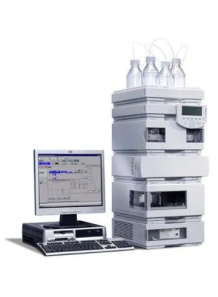HPLC Analysis of Ectoin Purity
- Product Code: 35668
HPLC Analysis of Ectoin Purity
description Service Overview
Protocol for HPLC purity analysis of Ectoin:
Materials Required:
HPLC system with UV/Vis detector
HPLC-grade solvents (e.g., water, acetonitrile)
Analytical column suitable for Ectoin analysis (e.g., C18 column)
Ectoin standard for calibration
Sample of Ectoin to be analyzed
Filtration system (0.2 μm pore size)
Micropipettes and syringes
Mobile phase buffer (if necessary)
Procedure:
Preparation of Mobile Phase:
Depending on the nature of Ectoin and its solubility, prepare an appropriate mobile phase. A typical mobile phase might consist of a mixture of water and acetonitrile in varying proportions, adjusted based on the compound's retention time and separation efficiency.
Column Equilibration:
Equilibrate the HPLC column with the mobile phase under the recommended conditions (temperature, flow rate, etc.). This step ensures that the column is ready for sample injection and provides consistent results.
Preparation of Standard Solution:
Prepare a standard solution of Ectoin by dissolving a known quantity of Ectoin standard in an appropriate solvent. The concentration should be within the linear range of the detector.
Sample Preparation:
If the sample is in a solid form, dissolve it in the appropriate solvent. Ensure that the sample is completely dissolved and free from particulates. Filter the solution through a 0.2 μm membrane filter to remove any insoluble impurities.
Calibration:
Inject a series of standard solutions with varying concentrations onto the HPLC system to generate a calibration curve. Use the detector response (e.g., peak area) to quantify the concentration of Ectoin in each standard solution.
Sample Injection:
Inject the prepared sample solution into the HPLC system using an appropriate injection volume. Ensure that the injection volume is within the linear range of the detector.
Chromatographic Separation:
Run the HPLC system under the optimized conditions for chromatographic separation of Ectoin and any impurities present in the sample. Monitor the detector response (e.g., UV absorbance) to detect and quantify Ectoin peaks.
Data Analysis:
Calculate the purity of the sample based on the peak area or peak height of Ectoin relative to the total area or height of all peaks in the chromatogram. Compare the retention time and peak shape of the sample with those of the standard to confirm the identity of Ectoin.
timeline Service Steps
| Step | Procedure | Expected Result |
|---|---|---|
| info Service steps will be provided upon request | ||
HPLC Analysis of Ectoin Purity
Protocol for HPLC purity analysis of Ectoin:
Materials Required:
HPLC system with UV/Vis detector
HPLC-grade solvents (e.g., water, acetonitrile)
Analytical column suitable for Ectoin analysis (e.g., C18 column)
Ectoin standard for calibration
Sample of Ectoin to be analyzed
Filtration system (0.2 μm pore size)
Micropipettes and syringes
Mobile phase buffer (if necessary)
Procedure:
Preparation of Mobile Phase:
Depending on the nature of Ectoin and its solubility, prepare an appropriate mobile phase. A typical mobile phase might consist of a mixture of water and acetonitrile in varying proportions, adjusted based on the compound's retention time and separation efficiency.
Column Equilibration:
Equilibrate the HPLC column with the mobile phase under the recommended conditions (temperature, flow rate, etc.). This step ensures that the column is ready for sample injection and provides consistent results.
Preparation of Standard Solution:
Prepare a standard solution of Ectoin by dissolving a known quantity of Ectoin standard in an appropriate solvent. The concentration should be within the linear range of the detector.
Sample Preparation:
If the sample is in a solid form, dissolve it in the appropriate solvent. Ensure that the sample is completely dissolved and free from particulates. Filter the solution through a 0.2 μm membrane filter to remove any insoluble impurities.
Calibration:
Inject a series of standard solutions with varying concentrations onto the HPLC system to generate a calibration curve. Use the detector response (e.g., peak area) to quantify the concentration of Ectoin in each standard solution.
Sample Injection:
Inject the prepared sample solution into the HPLC system using an appropriate injection volume. Ensure that the injection volume is within the linear range of the detector.
Chromatographic Separation:
Run the HPLC system under the optimized conditions for chromatographic separation of Ectoin and any impurities present in the sample. Monitor the detector response (e.g., UV absorbance) to detect and quantify Ectoin peaks.
Data Analysis:
Calculate the purity of the sample based on the peak area or peak height of Ectoin relative to the total area or height of all peaks in the chromatogram. Compare the retention time and peak shape of the sample with those of the standard to confirm the identity of Ectoin.
| Mechanism | - |
| Appearance | - |
| Longevity | - |
| Strength | - |
| Storage | - |
| Shelf Life | - |
| Allergen(s) | - |
| Dosage (Range) | - |
| Recommended Dosage | - |
| Dosage (Per Day) | - |
| Recommended Dosage (Per Day) | - |
| Mix Method | - |
| Heat Resistance | - |
| Stable in pH range | - |
| Solubility | - |
| Product Types | - |
| INCI | - |
Purchase History for
Cart
No products



